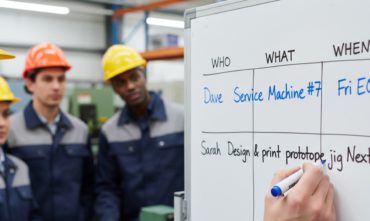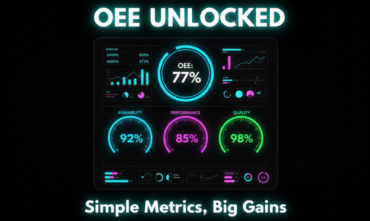
A Beginner’s Guide to 5S: How To Transform Your Workshop Into a Productivity Powerhouse
It’s Tuesday morning, you’re in the middle of a critical job, and you need that specific 13mm socket. You know, the one that’s supposed to be in the shared toolbox. You go to the drawer, and it’s a jumble of spanners, Allen keys from a job two years ago, and about five different tape measures, none of which work properly. The socket isn’t there.
You ask Dave. Dave shrugs. You ask Sarah. She thinks she saw it near the cutting machine last week. Ten minutes of your life you’ll never get back are spent just searching for a simple tool. Ten minutes of machine downtime. Ten minutes of mounting frustration. It’s not just annoying, is it? It’s inefficient, it’s costly, and to be frank, it’s a bit demoralising.
What if I told you there’s a systematic way to make that scenario a distant memory? A method born in the hyper-efficient world of Japanese manufacturing that can transform your workspace from a chaotic treasure hunt into a smooth, productive, and safer environment. It’s called 5S.
Now, before you roll your eyes at another bit of management jargon, hear me out. 5S isn’t about making your factory floor look pretty for a visit from head office. It’s a foundational principle of Lean manufacturing, a powerful system for eliminating waste. It’s about creating a workplace where everything has a place, problems can’t hide, and your team can focus on what they do best: adding value. In this guide, we’re going to walk through the five simple, actionable steps of 5S that you can start using today to reclaim your time, boost safety, and maybe even find that missing socket.
So, What Exactly is This 5S Thing?
At its heart, 5S is a five-step methodology for creating and maintaining an organised, clean, and high-performance workplace. The name comes from five Japanese words, each starting with ‘S’. Don’t worry, you don’t need to learn Japanese, but understanding the original terms helps grasp the philosophy behind them.
Here they are:
- Seiri (Sort): Separate the necessary from the unnecessary.
- Seiton (Set in Order): A place for everything, and everything in its place.
- Seiso (Shine): Clean the workspace and keep it clean.
- Seiketsu (Standardise): Create rules and habits to maintain the first three S’s.
- Shitsuke (Sustain): Make it a part of your culture. Keep the discipline.
It’s easy to look at that list and think, “Oh, so it’s just a fancy way of saying ‘have a big tidy up’.” And you’d be partly right, but you’d also be missing the most important part. 5S isn’t a one-off spring clean. It’s a continuous improvement system. The cleaning in ‘Shine’ is also a form of inspection. The organisation in ‘Set in Order’ is designed to make work flow smoother and faster. The discipline in ‘Sustain’ builds a culture of ownership and pride.
And this isn’t just for giant car plants in Japan. The principles of 5S apply everywhere. I’ve seen them work wonders in massive CNC machine shops, small fabrication workshops, sprawling warehouses, and even in company offices to manage server rooms and digital files. Anywhere there’s a process, there’s an opportunity to improve it with 5S. It’s the bedrock upon which all other Lean improvements are built. You can’t build a stable house on messy foundations, right? Same principle.
Your Step-by-Step Guide to Making 5S Happen
Alright, let’s get down to brass tacks. How do you actually do this? Here’s a practical breakdown of each step, with tips I’ve picked up from seeing it done right, and sometimes, done wrong.
Step 1: Sort (Seiri) – The Great Clear Out
The goal here is simple: get rid of everything you don’t need in the work area. Every broken tool, obsolete jig, out-of-date manual, and pile of ‘just in case’ materials is a physical and mental obstacle. It clutters the space, makes it harder to find what you actually need, and can even be a safety hazard.
How to do it:
- The Red Tag Method: Get a bunch of red tags and have your team go through their work area. Anything they are unsure about, broken, obsolete, or simply not needed for the current jobs gets a red tag. On the tag, they write what it is, why it’s being tagged, and the date.
- Create a Holding Area: Move all the red-tagged items to a designated ‘quarantine’ zone. This gets the clutter out of the way immediately, giving you a quick win, but doesn’t force irreversible decisions on the spot.
- Involve the Team: The people doing the work know what’s needed and what’s not. Don’t have a manager come in and start chucking things out. Let the operators and engineers lead the sorting. They’ll have more ownership of the final result.
Set a deadline, maybe a week or two, for people to review the items in the holding area. If someone can make a good case for keeping something, great. If an item is unclaimed and unused by the deadline, it’s time for it to go. Sell it, scrap it, recycle it. Just get it out.
The result? Suddenly you can see the floor. Your workbenches are clear. You’ll be surprised how much space you reclaim and how much easier it is to move around and find things.
Step 2: Set in Order (Seiton) – A Place for Everything
Now that you’re only left with the necessary items, it’s time to give them a proper home. The goal of Seiton is to arrange tools, parts, and information in a way that makes them easy to find, easy to use, and easy to put away. The mantra here is: “a place for everything, and everything in its place.”
How to do it:
- Think About Workflow: Don’t just arrange things neatly; arrange them logically. Tools used most frequently should be closest to hand. Items used together should be stored together. Think about the sequence of a job and place things in that order.
- Make it Visual: Use shadow boards, floor marking tape, and colour coding to make organisation intuitive. Shadow boards show where tools belong, while colour coding can differentiate items by type or function.
- Label Everything: Shelves, drawers, bins, cabinets—everything should be clearly labelled. No one should ever have to guess what’s inside something.
I was once in a factory that made hydraulic components. The assembly cell had a shared toolkit, and operators would waste, on average, four minutes per assembly searching for the right C spanner. They implemented Seiton. They created a custom foam insert for the toolbox drawer with a cutout for every single tool. The search time dropped to practically zero. Four minutes saved per assembly, multiple times a day, across a whole team. The savings were huge, and the team was so much happier. That’s the power of setting things in order.
Step 3: Shine (Seiso) – More Than Just a Mop and Bucket
This step is most often misunderstood. Seiso isn’t about hiring a cleaner. It’s about integrating cleaning into the daily work of the team. More importantly, it’s about using the act of cleaning as a method of inspection.
When you’re wiping down a machine, you’re not just making it look nice. You’re in a perfect position to spot a small oil leak, a frayed wire, a loose bolt, or a hairline crack in a safety guard. Finding these small problems early prevents them from becoming big, expensive, and dangerous problems later.
How to do it:
- Integrate, Don’t Delegate: Make cleaning part of the daily routine. A simple “5-minute shine” at the end of every shift can make a world of difference.
- Assign Zones: Break the work area into small, manageable zones and assign ownership for each zone to a specific person or team.
- Create Checklists: Develop simple daily or weekly cleaning checklists. For example: Wipe down control panel, check fluid levels, sweep floor around machine, check for leaks.
A quick win here is immediate. The first time an operator says, “While I was cleaning the press, I noticed this hydraulic fitting was weeping a little,” you’ve just paid for the entire Shine program. You’ve prevented a potential machine failure, a costly repair, and a dangerous slip hazard, all with a cloth and a bit of attention to detail.
Step 4: Standardise (Seiketsu) – Making it the New Normal
You’ve sorted, set in order, and shined. The place looks great. But how do you keep it that way? How do you stop it from slowly sliding back into chaos? That’s where Seiketsu comes in. The goal is to create a set of standards and procedures that lock in your improvements from the first three steps.
How to do it:
- Visual Standards are Key: Take photos of what the work area should look like in its ideal state and post them in the area. This provides a clear, unambiguous reference.
- Simple Checklists and SOPs: Create simple, one-page Standard Operating Procedures (SOPs) for 5S activities. This could be the daily cleaning checklist, a schedule for who is responsible for what, or a procedure for how new tools are introduced into the area.
- Integrate into Daily Work: The standards shouldn’t feel like an extra task. They should be part of the way work is done.
This step reduces variation between shifts and people, makes training new starters much easier, and ensures that the gains you’ve made are not lost the moment everyone gets busy.
Step 5: Sustain (Shitsuke) – Building the Habit
This is often the hardest step. Shitsuke is about discipline and building a culture where 5S is second nature. It’s about turning the new standards into ingrained habits. This requires leadership commitment and continuous effort.
How to do it:
- Leadership Walkabouts: Managers need to walk the floor, not to find fault, but to show they care. They should praise good examples of 5S, ask questions, and offer support.
- Regular Audits: Conduct regular, friendly 5S audits. Use a simple scoring system and display the results on a team board. This creates visibility and a bit of healthy competition.
- Recognition and Communication: Celebrate successes. When a team achieves a high audit score or makes a great improvement, recognise them in a team meeting or on a company notice board.
Sustain is an ongoing process. It never truly ends. It’s about fostering an environment of continuous improvement where everyone feels responsible for maintaining a safe, clean, and organised workplace.
Beyond the Steps: Making It Stick
Implementing the five steps is one thing; embedding 5S as the foundation of your operational culture is another. 5S isn’t an isolated project. It’s the launchpad for a broader Lean journey and a culture of Kaizen, or continuous improvement. When your workplace is organised and visual, problems have nowhere to hide. You start to see other forms of waste, like unnecessary motion, waiting time, or defects, much more clearly.
To keep the momentum going long term, you need consistent engagement from leadership, ongoing training, and a simple way to track your progress. Regular audits provide a structured way to assess how well each area is sustaining the 5S principles and offer a framework for constructive feedback. A good audit isn’t a test; it’s a health check.
The Results You Can Genuinely Expect
So, what’s the payoff for all this effort? It’s significant and it touches every part of your operation.
- Improved Safety: A clean, uncluttered workspace has fewer trip hazards. Properly stored tools and chemicals reduce risks. The ‘Shine’ stage uncovers equipment faults before they cause an accident. In a warehouse I worked with, they reduced minor incidents like trips and slips by over 60% in the first year after a thorough 5S implementation.
- Increased Productivity: Less time spent searching for tools means more time spent adding value. A clear workflow reduces unnecessary motion. Standardised processes mean less confusion and rework. That assembly cell I mentioned earlier? They increased their overall output by 12% without buying any new equipment, purely through 5S.
- Better Quality: When the workplace is organised and standardised, it’s easier to do the job right the first time. Mistakes are less likely when the correct tools and information are readily available.
- Higher Morale: Nobody enjoys working in a messy, chaotic, and frustrating environment. A clean and organised workplace shows that the company respects its employees and the work they do. It empowers them to take ownership and pride in their area, which is a massive, if often unmeasured, benefit.
Start Small, Start Today
Transforming an entire factory floor feels like a monumental task. But you don’t have to boil the ocean.
The beauty of 5S is that you can start small. Pick one area. Just one. It could be a single workbench, one assembly cell, or one storage rack. Get the team from that area together, give them this guide, and empower them to make a change this week.
Run through the five steps. Sort out the clutter. Give everything a home. Clean and inspect the area. Create a simple visual standard. And agree on how you’ll keep it that way. The visible improvement will be immediate, and that success will create the energy and enthusiasm to tackle the next area, and the next.
An organised, safe, and efficient workplace isn’t some far-off dream. It’s the result of small, consistent, disciplined actions, repeated every day. It’s within your reach, and it starts with the first S. So go on, find an area and get started. You’ll be amazed at the difference it makes.
If you’re ready to take the next step and build a true culture of continuous improvement, our Lean Training courses can provide your team with the skills and mindset to transform your entire operation. Get in touch to learn more.
More Blog Posts







To leave me a message or book a return call at a time that suits you








